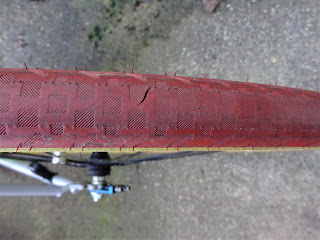John and Jane Moss have taken
the difficult decision to sell their Tandem trike, owned by them since 7th
July 1979. Well, back in 1979, it was a Peugeot touring tandem, and rebuilt as
a trike, back in 2007. https://www.sevendaycyclist.com/love-resurrection-john-moss-s-tandem
Much money has been spent
upgrading the drivetrain and braking. End of an era. However, John’s trike
focus, has turned almost exclusively to his Sinner Mango Velomobile. Sadly,
there’s no longer enough room, in his workshop, for both. Contact me, by email, if you are interested in buying their tandem trike.
Elsewhere, I’ve relocated
“Franenpute” sensor and magnet, to chainstay and rear wheel. This appears to
have solved the interference hassles, when SP PD8 and SL9 dynohubs https://www.sevendaycyclist.com/halo-evura-shutter-precision-sl9-dy
are switched on.
500 miles in, and I’ve also
warmed to the Passport Element Chain. At 802 kg, tensile strength is noticeably
lower than track type fare, such as KMC Z1 inox https://www.sevendaycyclist.com/kmc-inox-chain
(1050kg). These are almost twice the Passport’s asking price, so direct
comparisons are unfair.
I’m 70 kilos, so don’t tax
components in the same way a powerfully built, 90kilo rider will. Though I
noticed the difference in tensile strength, when powering along a climb. I’d be
happy popping one on a traditional winter/fixed conversion, single speed
freewheels; or hub geared road build.
More powerful riders, or those
living in hillier regions and who only run a single, front brake, would be
better served by something like the KMC. Nonetheless, true to claims, lubricant
clings to the rougher, galvanised texture.
This not only means it stays
put but there’s less clean up, and transference to hands/clothing. I’ve had to tweak tension, on a couple of
occasion, most recently this week, by the roadside.
For one, moral sapping moment,
my beloved and long serving Pedros Trixie multitool seemed elusive. Thankfully,
the 15mm head popped out from behind a tightly bound spare tube.
Back in September, the fixed
hub belonging to the Mavic Open Pro build expired. I’d switched to the Halo
Aerorage but pondered what to replace the Mavic’s no-name hub with. I’ve had no
problems with cheap hubs in the past. An On-One Inbred unit served a good
twelve years before expiry.
A simple cup n’ cone Maillard
double fixed unit, graced my first fixed gear build, which was based around a
501 Raleigh frameset. The Inbred is a better bet, for daily drivers cum hack
bikes, courtesy of sealed bearings and perfect for a utilitarian build. The
sort which needs to be reliable but not attract unwanted attention, when locked
to street furniture for longer periods.
Then this Halo rear fix G
track hub, was offered me by Ison Distribution https://www.ison-distribution.com/english/product.php?part=HUHATG2K
. Sealed bearings and hollow Cro-moly axles bode well for year-round/winter
service. Look closely and you’ll notice a HG cassette type assembly for loading
fixed sprockets.
Aside from the obvious convenience-no
need for medieval looking chain whips, this allows for an adjustable
chain-line, between 41and 52mm. Theoretically, a boon for older road
conversions. However, those looking to leave their frame spacing untouched may
find Surly New Road Rear https://www.ison-distribution.com/english/product.php?part=HUSURRDK
a better option.
Don’t be tempted to use HG
cassette sprockets with the rear fix G. Stick with 7mm Halo Fat foot, or Gusset
Double Six sprockets.
Then there’s an independent lock-ring,
that doesn’t have to deal with those rotational forces, traditionally
synonymous with fixed transmissions. Talking of which, it will also entertain
fixed sprockets between 12 and 20teeth. This should cater for pretty much every
occasion, including fixed gear cross/gravel antics.
Tioga City Slickers are
another definite favourite of mine and 25 years later, they’re much as I
recall, save for a new, “Energetic” 60tpi casing. Our samples are 700x32 but
there’s a 38mm option, and plenty to please those of us, still running 26inch
wheels.
I spent several years bombing
round the capital on 26x1.95s, which were quick and compliant. Literally
gliding over holes and lumpy ironworks. Punctures were rare events too. Or is
that nostalgia weaving its hypnotic spell. Several weeks and a few hundred
miles will tell.
One way, or the other. Right, better glue this nasty looking (though
thankfully, superficial) cut in the Soma Supple Vitesse EX casing. https://www.sevendaycyclist.com/soma-fabrications-vitesse
Before it expands, or a thorn, glass, or
similar sharp sneaks inside.



































